Plant Focus: Skimmia
A multiseasonal display for your landscape
Native to Eastern Asia, Skimmia is a genus from the plant family Rutaceae. Interestingly, the Rutaceae family of plants also contains citrus trees; if you crush the leaves of a Skimmia plant, they release a pleasant scent of citrus. Skimmia is an easy to care for, slow growing, versatile shrub and an incredibly showy species as it boasts lush foliage, berries, and flowers. Skimmia can range from 50cm to 1.5m in height, depending on the species and variety, and provides great structure with its upright and neat growth habit.
The rounded shrub has leathery, oval-shaped, dark green leaves and clusters of highly fragrant white, cream, or green flowers in spring. When in bloom, Skimmia is exceptionally striking as its dark green foliage contrasts beautifully with its showy blooms. Some varieties of Skimmia produce small, decorative, long-lasting berries in autumn and winter.
Key Characteristics of Skimmia:
✓ Evergreen
✓ Compact and rounded shrub
✓ Neat and upright habit
✓ Height range from 50cm to 1.5 depending on the variety
✓ Flowers in spring
✓ Produces berries in autumn and winter
✓ Low maintenance
✓ Plant all year round
✓ Grows best in neutral soils
✓ Most varieties prefer light shade
✓ Excellent source of nectar

Skimmia japonica subsp. reevesiana produces both male and female flowers.
Skimmia varieties are either male, female, or hermaphrodite. Female varieties will produce berries in autumn and winter if a male variety is in close proximity. Male varieties produce flower buds. Hermaphrodite varieties are ideal for small green spaces as they produce berries without the need for both male and female varieties. However, there are only a limited number of hermaphrodite varieties; one example is Skimmia japonica ‘Reevesiana’.
Fun Fact
Even though hermaphrodite Skimmia varieties produce berries without the need for both a female and male plant, they will go on to produce a more impressive show of berries if a male partner is nearby.
Adored by both butterflies and bees, Skimmia provides an abundance of benefits to wildlife and biodiversity, such as food and shelter, and a rich source of nectar for pollinators. Skimmia works well in a number of different planting themes, including wildlife, cottage, and woodland gardens.
Our favourite Skimmia varieties
Skimmia japonica is a particular species of Skimmia that originates from China, Japan, and Southeast Asia. It’s a dome-shaped, dense, evergreen shrub that grows from 50cm to 7m in height, although cultivars usually reach a maximum of 1.5m. Its foliage is aromatic, leathery and dark green in colour, and in spring, it blooms white, pink or red flushed flowers. Male plants have large, sweetly-scented flowerheads, whilst female plants have smaller flowerheads, followed by bright red fruits in summer, autumn and winter, if pollinated by a nearby male. There are many different varieties of Skimmia japonica which we go into below.


Skimmia japonica ‘Fragrans’
Skimmia japonica ‘Fragrans’
Commonly known as Japanese skimmia ‘Fragrans’, this is a male variety that grows up to 1.5m in height. This particularly fragrant variety forms a compact, low dome, with obovate, dark green leaves and white male flowers in April and May. It has an upright habit, making it excellent for containers or adding structure to a flower border.
Skimmia japonica ‘Fragrant Cloud’
Another male variety, Skimmia japonica ‘Fragrant Cloud’ is slightly smaller and reaches a height of around 1m. It has dark green, glossy, obovate leaves and blooms clusters of small, white flowers in spring. Its upright and bushy habit works well in containers and mixed borders to provide year-round interest and colour.
Skimmia japonica ‘Fructo Alba’
Skimmia japonica ‘Fructo Alba’ is a dwarf, rounded, female variety that grows up to around 60cm in height. It has leathery, lance-shaped to oval green leaves, alongside green flowers buds which open to lovely white flowers in spring, with clusters of glossy, white berries which follow, if pollinated by a nearby male plant.
Skimmia japonica ‘Kew White’
Skimmia japonica ‘Kew White’ is a compact, female variety with elliptic, rich green leaves and highly-scented white flowers. If it’s pollinated by a nearby male, Skimmia japonica ‘Kew White’ will form striking, snow-white autumn berries. It grows to around 1.5m in height and looks great when planted in borders and containers.
Skimmia japonica ‘Rubella’
Skimmia japonica ‘Rubella’ is a compact, male variety that has deep green foliage with red margins. In autumn, Skimmia japonica ‘Rubella’ boasts dark red flower buds until they later open to clusters of scented, white flowers in spring. A great choice for a male Skimmia when positioned in close proximity to a female variety. Grows up to around 1.5m in height and a great specimen for a pot.

Skimmia japonica ‘Rubella’
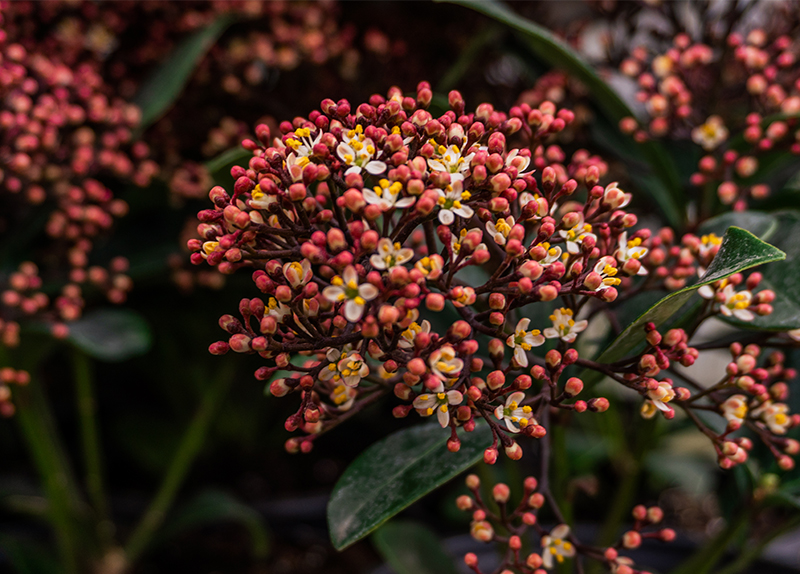
Skimmia japonica ‘Rubella’

Skimmia japonica ‘Rubella’
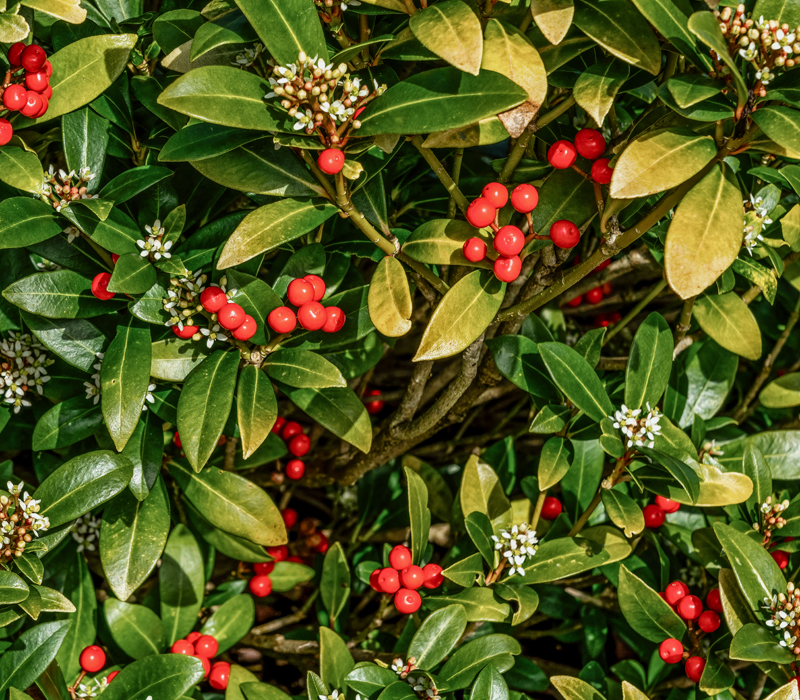
Skimmia japonica subsp. reevesiana
Skimmia japonica subsp. reevesiana
Skimmia japonica subsp. reevesiana is a hermaphrodite or self-fertile variety with narrow, dark green, evergreen leaves; pink or red tinged, white flowers in spring; and bright red berries in autumn. These berries provide excellent winter interest and grow well in the middle of borders, as well as in containers. It does not need a male variety nearby to pollinate and produce berries.
Skimmia × confusa ‘Kew Green’
A compact, dome-shaped, evergreen shrub that grows up to 1m in height, with clusters of creamy-white flowers which bloom from spring to summer. The majority of Skimmia plants prefer to be positioned in light shade; however, Skimmia × confusa ‘Kew Green’ thrives in full sun, so is a great choice for sunny borders.

Skimmia × confusa ‘Kew Green’

Skimmia × confusa ‘Kew Green’
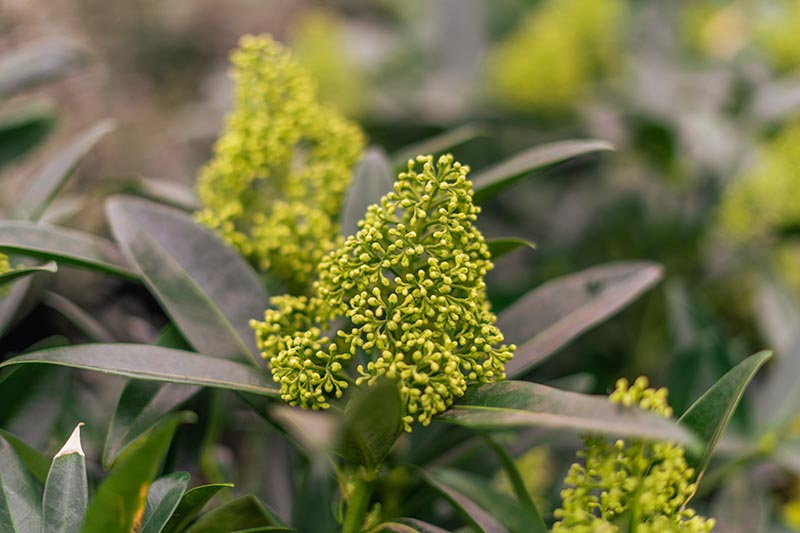
Skimmia × confusa ‘Kew Green’
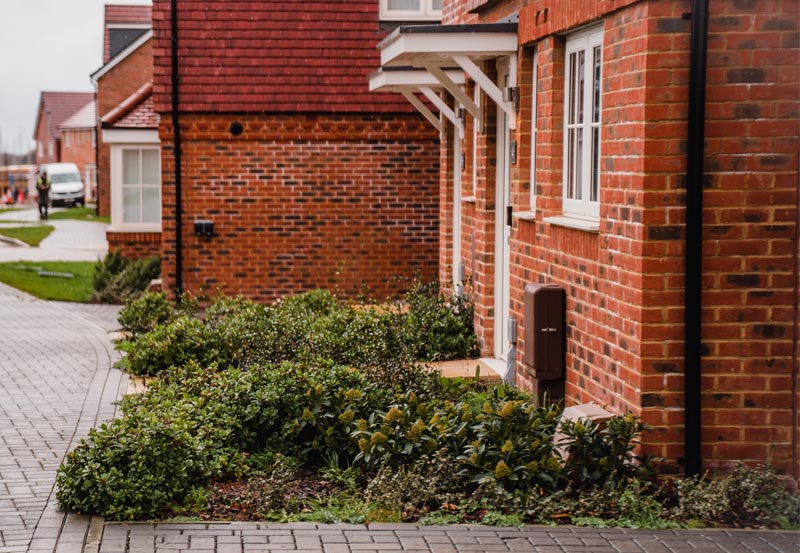
Skimmia planted in a homeowner’s new build front garden
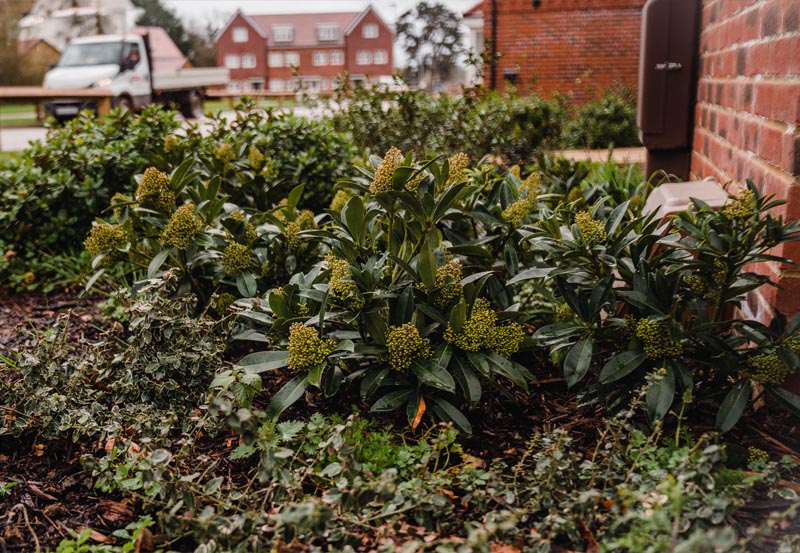
Skimmia helps to create colourful borders
How to grow Skimmia
Skimmia can be planted at any point during the year, except for times when the ground might be excessively dry, waterlogged, or frozen. For the most ideal establishment, planting is recommended in autumn or spring. Skimmia is great for growing in shady borders and containers, and its dense habit and evergreen foliage also makes it useful for low screening or hedges.
Skimmia usually prefers light shade, but can cope with full shade. However, Skimmia × confusa ‘Kew Green’ performs well in full sun. Most other varieties will struggle in sunny spots and the leaves will turn pale and yellow. Being incredibly hardy, Skimmia can tolerate frost and periods of drought. It’s a great option if you’re looking for drought-tolerant planting.
When it comes to soil preferences, Skimmia thrives in neutral soils. It can also tolerate alkaline soils, but it’s best to provide it with organic matter, such as compost and bark; these can help to neutralise the soil.
How to care for Skimmia
Skimmia is fairly low maintenance and easy to look after once established. Water thoroughly during the first 12-18 months—especially during dry spells. Once it’s established, it’s pretty drought tolerant, so can be watered less often. However, if it is in a sunny position or grown in a pot, ensure to keep watering regularly to stop it from drying out. You can also mulch the ground with a biodegradable mulch to help the soil retain its moisture. Skimmia doesn’t generally require plant feed, but if it doesn’t appear to be thriving, we advise using a general fertiliser in spring.
It’s not necessary for Skimmia to be regularly pruned. If you need to reshape by pruning any shoots, carry this out in spring to avoid frost damage to its branches. Additionally, it’s important to note that pruning female varieties can prevent the growth of berries during the next winter.
Which pests and diseases can Skimmia be affected by?
When it comes to pests and diseases, Skimmia is usually unaffected. However, can possibly be struck by leaf yellowing or horse chestnut scale. Leaf yellowing is normally caused by too much sun exposure, or considerably dry soil. If you spot any leaf yellowing, it’s best to move your Skimmia to a shadier spot—preferably during spring or autumn. Ensure to also feed with a general fertiliser, mulch the plant and water during dry weather.
Horse chestnut scale is a sap-sucking true bug that usually has a ‘scale’ appearance on plant foliage or stems. The insects suck sap from plants, leading to the production of honeydew. This can result in a sooty mould developing and is incredibly unsightly. Although the plant is usually unharmed, it can affect its aesthetic potential. The adult insects eventually die, leaving behind egg masses, which can be scraped off by hand and destroyed.
Overall, we think Skimmia is a truly fantastic, low maintenance addition to any green space, with its showstopping foliage, fragrant flowers, and colourful berries, providing multiple seasons of interest. Get in touch with one of our G Team experts if you need any advice or more information on the varieties of Skimmia we offer.

